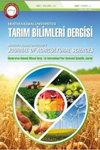Is the nutritional composition of safflower oilseed meal sufficient for alternative or complementary aqua feeds-raw material?
IF 1.1
4区 农林科学
Tarim Bilimleri Dergisi-journal of Agricultural Sciences
Pub Date : 2023-05-24
DOI:10.15832/ankutbd.1145841
引用次数: 0
Abstract
Safflower (Carthomus tinctorius L.) is grown in many countries, even in arid regions. Due to its important nutrients, safflower has the potential to be used as raw material for the nutrition of many animals and aquaculture species. For this reason, the objective of this study is to determine crude protein, crude oil, ash, and nitrogen-free extract (NFE) values, as well as amino acid, fatty acid, and mineral values, utilizing safflower meal is used instead of fish meal and soybean meal, wheat and canola meal as raw material for aquaculture feed. On a dry matter basis, the crude protein, crude oil, and NFE values were found at 19.42% ±0.32, 8.76% 0.21±, 2.84% 0.1± and 62.68% ±0.88 respectively. Safflower meal contains significant arginine, histidine, and phenylalanine levels, with C18:2 n-6 being one of the most abundant fatty acids. According to the fatty acid values examined, the total saturated fatty acid values were to be 9.79%; the total monounsaturated fatty acid values are 27.58%; total n-6 PUFA values are 61.49%; total n-3 fatty acid values are 0.55% and total n-3 HUFA values are 0.22% in safflower oilseed meal. In terms of potassium and magnesium content, similar to soybean meal and fish meal. Safflower oilseed plant meal or oil can be used as complementary raw material in both marine and freshwater fish feeds. At this point, observing the balance of essential amino acids and polyunsaturated fatty acids in the diets and conducting detailed studies would be effective at further closing the gap in this field.红花油籽粕的营养成分是否足以替代或补充水产饲料原料?
红花(Carthomus tinctorius L.)生长在许多国家,甚至在干旱地区。由于其重要的营养成分,红花有潜力被用作许多动物和水产养殖物种的营养原料。因此,本研究的目的是利用红花粕代替鱼粉和豆粕、小麦和菜籽粕作为水产养殖饲料的原料,测定其粗蛋白质、粗原油、灰分和无氮提取物(NFE)的价值以及氨基酸、脂肪酸和矿物质的价值。在干物质基础上,粗蛋白质、原油和NFE值分别为19.42%±0.32、8.76% 0.21±、2.84% 0.1±和62.68%±0.88。红花粉含有大量的精氨酸、组氨酸和苯丙氨酸,其中C18:2 n-6是最丰富的脂肪酸之一。根据脂肪酸值测定,总饱和脂肪酸值为9.79%;总单不饱和脂肪酸值为27.58%;总n-6 PUFA值为61.49%;红花油籽粕中总n-3脂肪酸值为0.55%,总n-3 HUFA值为0.22%。在钾和镁含量方面,与豆粕和鱼粉相似。红花油籽植物粕或植物油可作为海鱼和淡水鱼饲料的补充原料。在这一点上,观察饲粮中必需氨基酸和多不饱和脂肪酸的平衡并进行详细的研究将有效地进一步缩小这一领域的差距。
本文章由计算机程序翻译,如有差异,请以英文原文为准。
求助全文
约1分钟内获得全文
求助全文
来源期刊
CiteScore
1.40
自引率
0.00%
发文量
26
期刊介绍:
Journal of Agricultural Sciences (JAS) is an international, double-blind peer-reviewed, open-access journal, published by the Faculty of Agriculture, Ankara University. The journal invites original research papers containing new insight into any aspect of Agricultural Sciences that are not published or not being considered for publication elsewhere. Preliminary, confirmatory or inconclusive research, review articles, case and local studies and works presenting taxonomy will not be published.

 求助内容:
求助内容: 应助结果提醒方式:
应助结果提醒方式:


